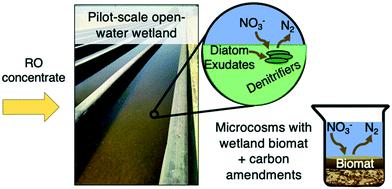当前位置:
X-MOL 学术
›
Environ. Sci.: Water Res. Technol.
›
论文详情
Our official English website, www.x-mol.net, welcomes your
feedback! (Note: you will need to create a separate account there.)
Nitrate removal from reverse osmosis concentrate in pilot-scale open-water unit process wetlands
Environmental Science: Water Research & Technology ( IF 3.5 ) Pub Date : 2021-2-16 , DOI: 10.1039/d0ew00911c Rachel C. Scholes 1, 2, 3, 4, 5 , Michael A. Vega 1, 4, 5, 6, 7 , Jonathan O. Sharp 1, 4, 5, 6, 7 , David L. Sedlak 1, 2, 3, 4, 5
Environmental Science: Water Research & Technology ( IF 3.5 ) Pub Date : 2021-2-16 , DOI: 10.1039/d0ew00911c Rachel C. Scholes 1, 2, 3, 4, 5 , Michael A. Vega 1, 4, 5, 6, 7 , Jonathan O. Sharp 1, 4, 5, 6, 7 , David L. Sedlak 1, 2, 3, 4, 5
Affiliation

|
Biological treatment of nitrate in reverse osmosis (RO) concentrate produced from municipal wastewater effluent is challenging, in part because of the low carbon-to-nitrogen ratio. Open-water unit process wetlands may provide a cost-effective means of removing nitrate because autotrophic production of labile organic carbon supports denitrification in the wetland biomat. To determine the potential for employing open-water unit process wetlands for removing dissolved nitrogen species from RO concentrate, a pilot-scale open-water wetland treatment system was established and studied over a two-year period at a water reuse facility in San Jose, California. The system was operated with a 3-day hydraulic residence time, resulting in removal of up to 30% of the nitrate present in the RO concentrate during the first summer of operation and removal of up to 47% of the nitrate during the second summer. The biomat comprised a diverse algal and heterotrophic bacterial assemblage containing several clades that are putatively capable of denitrification, as well as greater abundances of denitrifying functional genes (nirK, narG) in the second year, coincident with higher nitrate removal. In batch reactors, the addition of woodchips increased nitrate removal rates from RO concentrate by approximately a factor of five or more, with rates dependent on the dose of woodchips applied. These results indicate that woodchip amendments could reduce the land area needed for nitrate treatment. This study provides evidence that open-water wetlands can remove nitrate from RO concentrate at the pilot scale, and identifies opportunities to enhance treatment efficiency with low-cost carbon amendments.
中文翻译:

中试规模开放水单元工艺湿地中反渗透浓缩物中的硝酸盐去除
从市政废水中产生的反渗透(RO)精矿中硝酸盐的生物处理面临挑战,部分原因是碳氮比低。开阔水单元工艺湿地可能提供去除硝酸盐的经济有效的方法,因为不稳定有机碳的自养生产支持湿地生物垫中的反硝化作用。为了确定使用开放水单元工艺湿地去除RO精矿中溶解氮物质的潜力,建立了中试规模的开放水湿地处理系统,并在圣何塞的中水回用设施进行了为期两年的研究,加利福尼亚 系统以3天的液压停留时间运行,导致在操作的第一个夏季除去RO精矿中硝酸盐的含量高达30%,在第二个夏季除去高达47%的硝酸盐。该生物垫包含各种藻类和异养细菌组合,其中包含几个进化论断定的进化枝,以及更多的反硝化功能基因(第二年,Nir K,nar G),同时硝酸盐去除率更高。在间歇式反应器中,木屑的添加使反渗透浓缩物中硝酸盐的去除率提高了大约五倍或更多,且去除率取决于木屑的剂量。这些结果表明,木片的修改可以减少硝酸盐处理所需的土地面积。这项研究提供了证据,证明开阔水域的湿地可以在试验规模上从RO精矿中去除硝酸盐,并发现了通过低成本碳修正来提高处理效率的机会。
更新日期:2021-02-19
中文翻译:

中试规模开放水单元工艺湿地中反渗透浓缩物中的硝酸盐去除
从市政废水中产生的反渗透(RO)精矿中硝酸盐的生物处理面临挑战,部分原因是碳氮比低。开阔水单元工艺湿地可能提供去除硝酸盐的经济有效的方法,因为不稳定有机碳的自养生产支持湿地生物垫中的反硝化作用。为了确定使用开放水单元工艺湿地去除RO精矿中溶解氮物质的潜力,建立了中试规模的开放水湿地处理系统,并在圣何塞的中水回用设施进行了为期两年的研究,加利福尼亚 系统以3天的液压停留时间运行,导致在操作的第一个夏季除去RO精矿中硝酸盐的含量高达30%,在第二个夏季除去高达47%的硝酸盐。该生物垫包含各种藻类和异养细菌组合,其中包含几个进化论断定的进化枝,以及更多的反硝化功能基因(第二年,Nir K,nar G),同时硝酸盐去除率更高。在间歇式反应器中,木屑的添加使反渗透浓缩物中硝酸盐的去除率提高了大约五倍或更多,且去除率取决于木屑的剂量。这些结果表明,木片的修改可以减少硝酸盐处理所需的土地面积。这项研究提供了证据,证明开阔水域的湿地可以在试验规模上从RO精矿中去除硝酸盐,并发现了通过低成本碳修正来提高处理效率的机会。











































 京公网安备 11010802027423号
京公网安备 11010802027423号